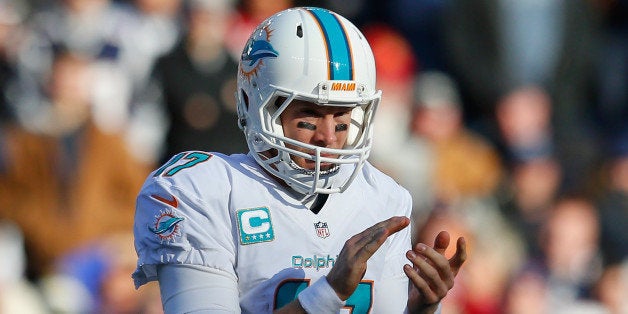
Last Monday, the Miami Dolphins signed Quarterback Ryan Tannehill to a six-year contract worth $96 million, with $21.5 million fully guaranteed. The Tannehill deal is aligned with the trend of teams committing to their unproven signal-callers with a risk conscious deal structure. Although Tannehill's deal carries with it the type of number we would come to expect of a starting NFL Quarterback, his performance over the course of the contract will dictate how the heavy majority of the contract plays out.
At first glance the figures provide enough shock value for a player like Tannehill as he has yet to fully emerge as a top tier talent. When the deal is broken down, however, it is actually very advantageous for the Miami Dolphins. First, as CBS NFL Insider Jason La Canfora noted, the Dolphins previously picked up the fifth-year option on Tannehill under his rookie contract, which would have paid him $16.2 million in 2016. Under the new deal this means that the Dolphins, over the course of 2015 and 2016, are only paying Tannehill $7 million more than he would have already earned. After posting career best numbers last year (66.4 completion percentage and 27-12 TD/INT ration), and showing consistent improvement throughout his career, that $7 million is an absolute discount for what the Dolphins get in return.
Signing a QB to a long-term deal shows highly sought-after free agents a commitment to stability in the position. It gives the young QB a confidence boost that he is doing the right things and sends a message to the rest of the team that they need to get behind him if they are going to make a push. Outside of the unquantifiable benefits, the $7 million also buys the Dolphins the ability to decide on Tannehill's fate early on in the deal and again shortly thereafter.
La Canfora's analysis provides that if Tannehill actually lives up to what the Dolphins are hoping to get from him, they will end up having an elite quarterback at a significant discount. If the Dolphins decide to pick up the 2017 contract option, which they would only do if Tannehill proves to be a top tier QB, they will pay him $14.5 million. The perfect barometer for this figure is the exclusive franchise tag which La Canfora estimates will be about $25 million at that time. So, without any risk whatsoever, in 2017 the Dolphins would have an elite QB for about a $10 million discount, and after 2017 the Dolphins can still back out of the remaining three years, which present the heaviest portion of the contract, where Tannehill will earn around $57 million.
The timing of the deal also makes a ton of sense for the Dolphins. It is clear that they believe in the ability of Tannehill to potentially emerge as an elite QB. If they would have waited another year for that to happen the deal would have played out much differently, with a much higher guarantee and far more risk. Furthermore there are a number of quarterback deals on the horizon that will raise the bar and would have driven Tannehill's figures up regardless of whether he was considered to be in the same class as those other Quarterbacks. From every angle, the Dolphins have played this one out perfectly and are a perfect case study for teams facing a similar situation in the future.
In the grander scheme of things, the analysis of this risk adverse deal points to the fact that the NFL is unlike any other professional sport in terms of the severity of stake for players on a week-to-week basis. In any other league it would be unfathomable to subject a team's centerpiece to the yearly scrutiny Tannehill will be under. Let's remember that Tannehill was the 8th overall pick only three years ago. Investing in a slightly unproven, but promising, commodity in any other sport would generally be viewed as a smart investment and there would be no protection for a team if that player flakes out. This is not the case in the NFL. Unless you have shown that you are undoubtedly the future of the franchise you will be under the constant pressure of performance. And even if you are that proven commodity you can be dropped at the flick of the wrist, with your earnings dramatically altered.